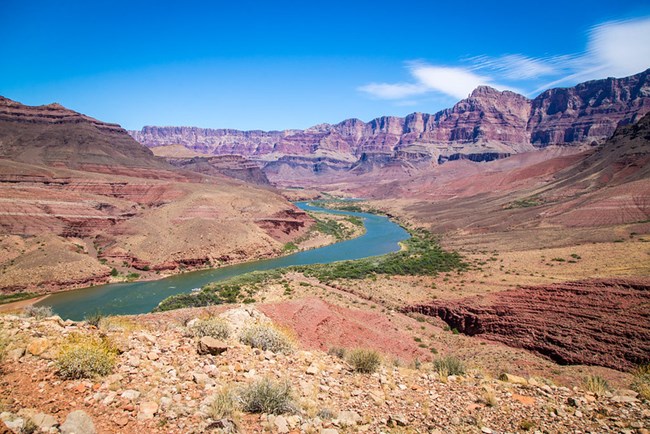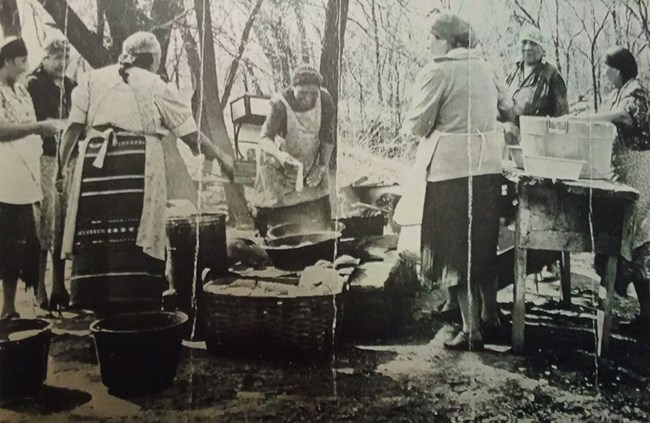Below, are a few of the accomplishments reported and published herein with participation and approval of the THPO. The function(s) to which the accomplishment applies is designated in the first paragraph of each accomplishment.

Elk Valley Rancheria
Sand Bread to Salmon: Celebrating Traditions of Elk Valley Rancheria at Culture Day
Function 7 - provide public information, education, and training; and technical assistance in historic preservation.
From toddlers to elders, Elk Valley Rancheria tribal members participated in the 2021 Culture Day. This celebration encourages children to interact with elders to learn traditions, such as basket weaving and drum making.
Events at Culture Day include basket weaving and sand bread making for the women, and drum making and salmon cooking for the men. The sand bread is made with a secret recipe! Two female tribal elders prepare the bread, cover it in beach gravel, and bake it by the fire. Tribal members enjoy eating the bread with toppings, such as homemade huckleberry jam.
The day concludes with a salmon feast prepared by the men. When possible, Rick Warner and others catch the salmon from the Pacific Ocean. Sometimes, the tribe purchases the salmon from nearby tribes. They then skewer the salmon with redwood sticks and stake it over an alder wood fire.
LaWanda’s daughter, who is fourteen and travels from New Hampshire to attend Culture Day, looks forward to it every year! The event started in 2004 and occurred annually until 2020, when the tribe cancelled the event because of the pandemic. Culture Day resumed in 2021 and the Tribe had one of the biggest turnouts in years!
Culture Day brings together tribal members from across the United States. The THPO and planning committee work together to make the most out of the tribe's time together. In addition to cultural events, organizations such as Indian Health Services are invited, and Redwood National Park assisted in an ethnographic study of elders at Culture Day.
Culture Day is important to bring everyone together and celebrate the traditional way of life for Elk Valley Rancheria tribal members.

Yurok THPO
Coming Home: First Tribally-Operated California State Park Visitor Center
Functions 5 - advise and assist, as appropriate, Federal and State agencies and local governments in carrying out their historic preservation responsibilities; 7- provide public information, education, and training; and technical assistance in historic preservation.
In 2022, after delays because of the pandemic, the Yurok Tribe celebrated the opening of the first tribally-operated visitor center within the California State Park system. The buildings and exhibits were completed in 2021, but due to the pandemic, it was not safe for people to mingle until 2022. The visitor center is located within North Coast Redwoods California State Park’s Humboldt Lagoon State Park. It is at the Yurok location of Chah-pekw O’ Ket’-toh (Stone Lagoon), which is an important place for Yurok history and cultural revitalization.
Yurok families lived in villages near the coastal lagoons for countless generations in relative peace until the California gold rush in the mid-nineteenth century. Despite several devastating atrocities, the Yurok people were never removed from this region, and many Yurok citizens are descendants of the villagers who survived.
According to Joseph L. James, Chairman of the Yurok Tribe, in a press release for the grand opening, “The restoration of our role as the steward of Chah-pekw O’ Ket’-toh represents a significant step toward the healing of our people.”
The Yurok Tribe now manages the visitor center, including exhibits, gift shop, and programming in coordination with the State Park through a Joint Powers Agreement. Additionally, the visitor center now includes digital and conventional displays, explaining the tribe’s longstanding cultural connection to the lagoon from pre-contact to contemporary times.
Over 150 tribal and state park officials, state and federal congressional members, and agency representatives attended the grand opening of the visitor center. The event was broadcast by Parks California and featured commentary from the tribe; Yurok elders explained the tribe's relationship to the coastal lagoon, California State Parks, and Redwood National Park.

Daniel Byers, Skyship Films
Importance of Place: Glen Canyon Dam Adaptive Management Program
Functions 5 - advise and assist, as appropriate, Federal and State agencies and local governments in carrying out their historic preservation responsibilities; 7- provide public information, education, and training; and technical assistance in historic preservation; 9 - consult with appropriate Federal agencies in accordance with this section on (A) Federal undertakings that may affect historic property; and (B) the content and sufficiency of any plans developed to protect, manage, or reduce or mitigate harm to that property
The Grand Canyon provides a tremendous sense of place for multiple tribes, including Zuni. The Glen Canyon Dam is upstream of the Grand Canyon, and it releases Colorado River water through the Grand Canyon. The dam alters the water flow of the river, eroding sacred sites (including ancestral (archaeological) places) and altering the habitat of plants and animals.
The Zuni provide annual reports based on their participation in the Glen Canyon Dam Adaptive Management Program based on the results of their annual river monitoring trips. At the Glen Canyon Dam Adaptive Management Program’s Annual Reporting Meeting in 2021, Zuni THPO Kurt Dongoske organized and chaired a panel titled, “Place, Time, and Consciousness in the Glen Canyon Dam Adaptive Management Program.” Per Dr. Dongoske, “The goal of the session was to emphasize to the Department of the Interior agencies that an insular adherence to a Western science as the sole source of knowledge in the management of the Grand Canyon and Colorado River ecosystem unintentionally disenfranchises the participating Tribes’ knowledge and understanding of the place that is sacred and central to their respective cultural identity.”
Commonly held western assumptions view time as linear and place is known by physical characteristics of a geographical place. Over the last 23 years of the Glen Canyon Adaptive Management Program, these assumptions have not been critically challenged. This insular adherence to a western science has largely disregarded the five tribes' (Pueblo of Zuni, Hopi Tribe, Southern Paiute Consortium, Navajo Nation, and Hualapai Tribe) perspectives of the Grand Canyon and Colorado River.
For these tribes, place is much more than a geographical location; place provides a sense of identity, purpose, connection, and grounding. The Grand Canyon provides tribes with a tremendous sense of place and a profound stewardship responsibility to the ancestors. For many tribes, including the Zuni, a sense of place is defined by the proper treatment of plants, animals, rivers, and mountains.
The western assumptions of place, time, and consciousness dismisses the stewardship obligations to the ancestors and all nonhuman life forms of the Colorado River through the Grand Canyon.

Coeur d'Alene THPO
Harvesting Camas Root, Biscuit Root and Bitter Root
Function 7 - provide public information, education, and training; and technical assistance in historic preservation.
In fall 2021, the Coeur d'Alene THPO Jill Wagner and the Deputy THPO Nicholas Kager met with children ages two through twelve in the Tribe’s Teaching Garden to teach them about traditional autumn practices.
The children listened to traditional stories, practiced archery, and picked the pumpkins which they had helped plant earlier in the year. They also learned how to use traditional tools, such as the pitse’, to dig potatoes and carrots. A pitse’ is a digging stick used to unearth vegetables.
The children loved learning how to use a pitse’ and were shocked about how much soil the tool was able to move. Traditionally, pitse’ were used to dig native foods, such as camas root, biscuit root, and bitter root. Then, these foods were prepared in steam baked pits for three days to turn them into a sweet molasses-like treat.

Pawnee THPO
Pawnee THPO and BIA Identify Ceremonial Grounds
Function 1 - In cooperation with Federal and State agencies, local governments, and private organizations and individuals, direct and conduct a comprehensive survey of historic properties on tribal land and maintain inventories of such properties
A ceremonial site used since the 1890s was in danger. A leasee wanted to bulldoze an existing fence line to clear the area of trees and build a new fence. The land contained at least one traditional dance arbor and has been the site of Ghost Dances and the tribe’s Kûskâharû ceremony with their Wichita relatives. This ceremony has roots dating back to at least 1300 and remains an annual event.
So, in 2021, Pawnee Nation THPO Matt Reed did a pedestrian survey in Oklahoma as part of a Section 106 Review for an agricultural lease. Matt investigated this lease for a violation of ARPA and determined there was no violation, yet the call was the impetus to survey the land. He then walked the property to identify sites of historical interest. A couple days later, the Bureau of Indian Affairs hired an archaeological contractor to perform a professional survey. Matt and the archaeological contractor conducted another pedestrian survey to locate the old dance arbor site. During this survey, they successfully located the dance arbor and found a cook stove in situ, likely used for making frybread for feasts.
Traditionally, the ceremonies include a feast at midday with foods such as meat, boiled potatoes, corn soup, and fry bread. The feasts are prepared by an invited cook, and the cook assigns men and women specific duties. Typically, women prepare the frybread and potatoes, and men prepare the meat and corn soup. During the ceremonies the food is served in a specific layout in the center of the dance arbor and served by designated men.
The contractor spent about a month identifying and documenting the site, which resulted in the creation of a new trinomial site, the discovery and protection of an old ceremonial site, and redefining how and what Matt helps to protect in Pawnee Country. This survey resulted in the discovery of important aspects of Pawnee’s culture and history connected to an allotment. Bundle Keepers, ceremonial leaders, dance arbors, and earthlodges are clustered throughout the reservation, affirming these locations had a purpose.

Shawnee Tribe THPO
Shawnee Tribe Affirms Connections to Serpent Mound and Educates Visitors
Functions: 5- advise and assist, as appropriate, Federal and State agencies and local governments in carrying out their historic preservation responsibilities; 7- provide public information, education, and training; and technical assistance in historic preservation.
Serpent Mound is a National Historic Landmark in Peebles, Ohio, and is the world’s largest serpent shaped effigy. The ancestors of the Shawnee Tribe built the serpent shaped mounds, and in 2021 the state of Ohio welcomed the tribe back to present the interpretation of the mound.
On June 18, 2021, the Chief of the Shawnee Tribe, Ben Barnes, the Shawnee THPO, Tonya Tipton, the Cultural and Historical Preservation Committee, the Chief of the Eastern Shawnee Tribe, Glenna Wallace, and the Eastern Shawnee THPO Paul Barton returned to the Serpent Mound to hold presentations on the Shawnee tribe’s relationship to the mound. They held presentations for three days, concluding on the summer solstice, June 20. On the summer solstice, the head of the Serpent aligns with the setting sun, and on the winter solstice it aligns with the coiled tail, signifying its ceremonial purpose.
Here are some additional links if you would like to learn more about Serpent Mound:
https://indiancountrytoday.com/news/shawnee-relcaim-great-serpent-mound
https://www.instagram.com/p/CQrSJTzJpZg/?utm_medium=copy_link
Last updated: September 7, 2022
